Played on PC
Less than ten years have passed (just a couple of weeks were not enough) since the release of Dragon Age: Inquisition, the Dragon Age universe is once again open to adventurers and connoisseurs of an exciting role-playing experience. The new game in the series rushes right off the bat: our old friend Solas begins a ritual, because of which the entire area is filled with demons hungry for blood, the city is flooded with chaos, and the only hope to prevent the massacre is Rook (us) and a detachment of our loyal allies. Having broken through in battle, we manage to stop Solas, but it would be hasty to celebrate the victory – because of the interrupted ritual, the most dangerous entities have made their way into the reality of mortals – the ancient elven gods, who promise truly dark times for all that exists…
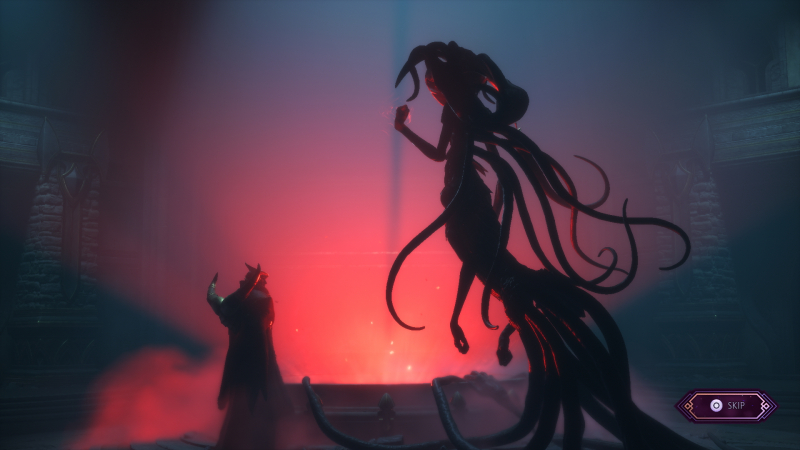
The ancient “gods” turned out to be truly terrifying. You believe in their fundamental cruelty and absolute power at first sight
⇡#Dragon Effect
You can’t start talking about role-playing games without touching on the core of the basics – character creation. In terms of the appearance editor, Dragon Age: The Veilguard meets all industry standards – there are many options for appearance and visual features, and assembling a character to your liking can easily take a good half hour – it took me about five minutes to select the right horns for my Qunari warrior. By the way, it’s definitely worth paying attention to the appearance of the characters, because the characters you create will be present in every video, of which there are incredibly many in The Veilguard.
The choice of role-playing features is also important, which will affect the attitude of certain factions or characters towards us. The choice of the past and devotion to one of the forces of this world, for example, will be reflected in special dialogues with other representatives of the faction (for this case, the game has a considerable number of additional lines in stock). This choice will also entail more global consequences, such as the rate of growth of the faction’s strength – this will play an important role closer to the end.
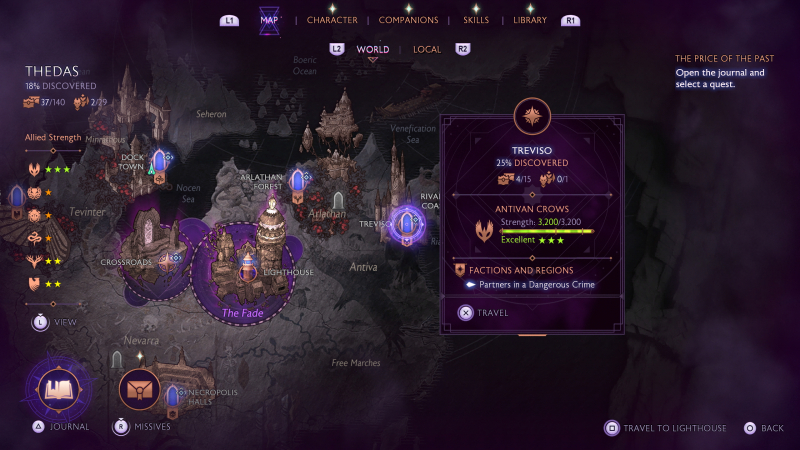
The current strength of a faction can be viewed directly on the global map. Comfortable!
But what was somewhat disappointing in a role-playing sense was the inability to transfer your save and elections from the “Inquisition”. You can, of course, manually make key decisions from the threequel, but the game will no longer take into account a bunch of other forks that are less significant for the world, but so important for us, although there was such an opportunity in the previous parts. And this, of course, will slightly overshadow the first impressions for the most devoted fans of the series.
But the new Dragon Age is true to tradition in the class selection field. And while the classic trio of mage, warrior and rogue is unlikely to impress seasoned adventurers, one look at the skill tree and the number of opportunities for development opens up a truly impressive scope for building a powerful and unique build. Basically, The Veilguard offers three main specializations for each class, but in fact the field for experimentation is much wider.
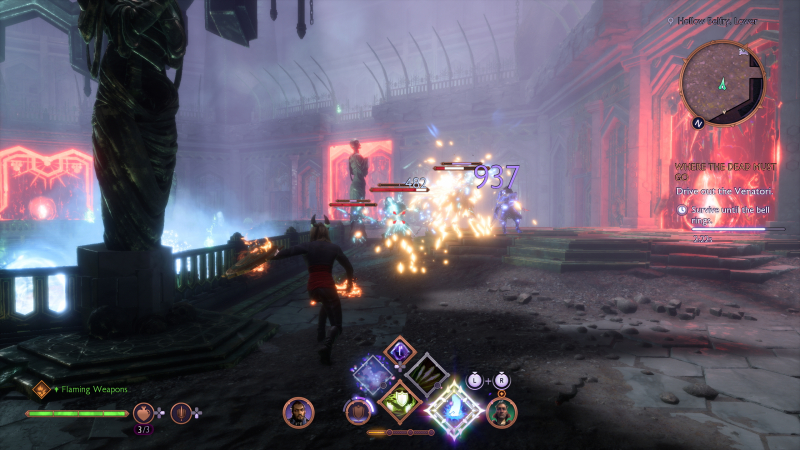
My favorite for the first playthrough was the warrior class – dashingly throws a shield like Captain America, and flies into battle with the fury of Kratos
For example, you can turn a warrior into a reaper who relies on necrotic damage and manipulation of his own health indicator; or – a champion who relies on a faithful shield, strong armor and crushing (literally) abilities; and fans of two-handed gizmos and huge explosive damage will definitely appreciate the killer. Magic lovers have a choice between the schools of necromancy, ice or electricity, and convinced robbers are presented with options in the form of duelists (for fans of solving issues face to face), saboteurs (turrets and traps will do most of the work) or rangers (bow and arrows are the main arguments in any collision). And although you can only choose one specialization, an extensive set of general skills and equipment will help you find your individual fighting style.
The series finally moved away from the tactical combat system (although the desire to be more dynamic was already felt in Dragon Age: Inquisition) and moved into the camp of full-fledged role-playing action games. And, fully understanding the disappointment of connoisseurs of tactical depth, I can confidently say: the new combat system suits the game. Yes, on the one hand, the thoughtfulness in the process has decreased, but the dynamics have noticeably increased, the pace has increased, and local fights give much more courage. And with the current scope and speed of the narrative, tactical battles would combine much worse.
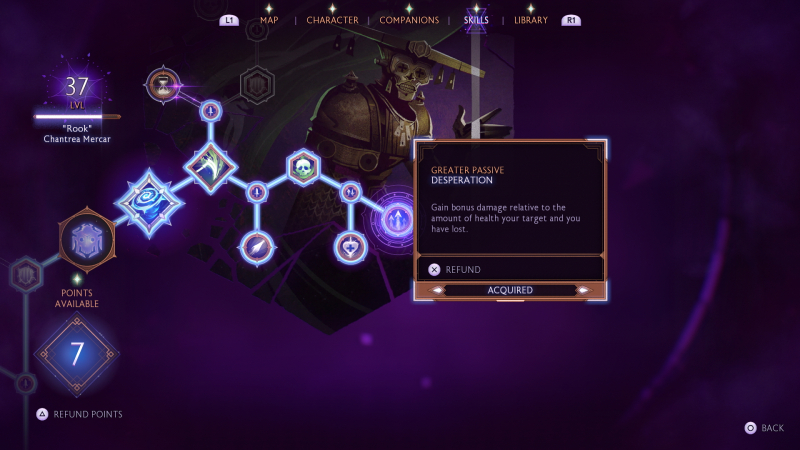
You can rebuild your build at any time and absolutely free, but you can change the class only by starting a new game
As for the direct tactile experience, the new combat system of Dragon Age: The Veilguard turned out to be excellent – fast-paced, spectacular, varied. Almost every fight is an intense challenge; There are enough enemies of different strengths and characteristics that you have to change your approach to battles; and the progression system is perfectly balanced. Right up to the finals, you want to increase your level, try new techniques and tirelessly find power-ups for your equipment. By the way, this aspect is implemented in a non-trivial way in The Veilguard: almost all weapons and armor (except for unique ones) can be combined with an analogue, which will increase the rarity of the item up to legendary and increase its combat potential. You don’t have to give up your favorite thing for something less interesting, but offering better performance. The indicators themselves, by the way, can also be increased – with a special artisan in your home location.
The tactical element has not disappeared completely, but has changed quite a lot: now in battle you can call up a submenu and slowly give orders to two companions, or use one of your skills. But you can also perform all tactical maneuvers on the fly, thanks to a fairly user-friendly interface. And if you thought that Dragon Age was starting to look a lot like Mass Effect… you didn’t think so.
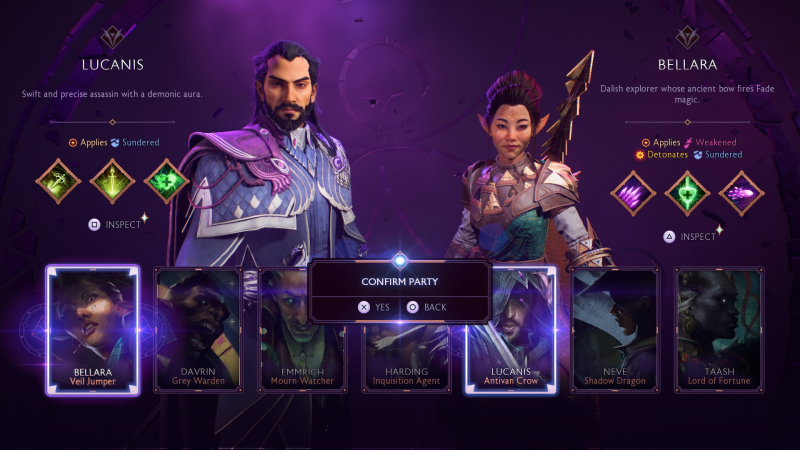
Companions in The Veilguard have a tangible impact on the battle: they have destructive abilities, and can heal, or even raise Ruk to her feet if she has received fatal damage
By the way, the similarities do not end with the nuances of the combat system. In The Veilguard, the speed of the narrative is much closer to the saga of Captain Shepard than to the previous parts of Dragon Age, and the scale of events is much more global (not the Reaper invasion, but still), and the structure of the game has become more reminiscent of the adventures of the Normandy crew. And this, suddenly, turns out to suit the project!
⇡#Divine scope and human intimacy
The main story of Dragon Age: The Veilguard is built around a global cataclysm that threatens all life in this world. Ancient elven magicians have escaped from centuries-old imprisonment, whose power and skill in blood magic in the eyes of many makes them living gods. Their incredible cruelty and despotic disposition are also legendary, which does not even promise a chance for a peaceful resolution of the conflict. The last hope of this world remains us, our faithful companions, wavering allies and the old enemy, now languishing in the imprisonment of shadow space.
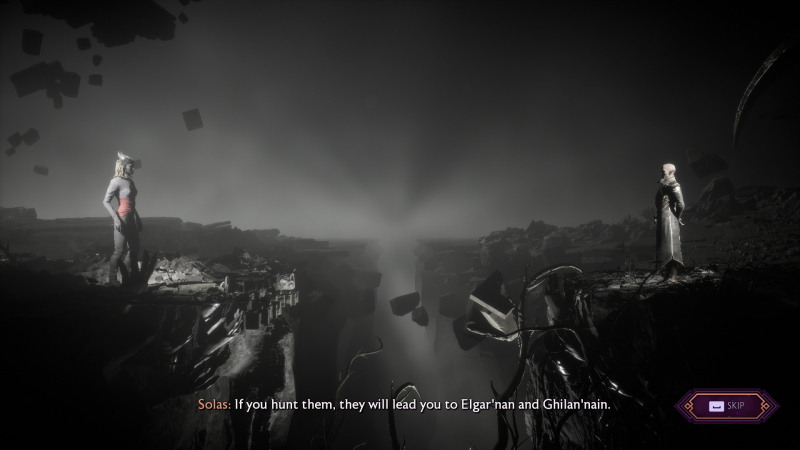
Solas is ready to help overthrow the gods, but his motives are still in doubt…
And although the main arc is written in broad strokes, full of spectacular collisions, tragic episodes and intense action, the main dish for many fans is the stories of our closest allies. Traditionally for BioWare (even in Mass Effect: Andromeda, the stories of companions were the best element of the game), all seven are not only effective combat comrades, but also full-fledged individuals with complex characters, personal demons (some – metaphorically, some – literally) and, of course, many different dilemmas that darken already difficult times.
And, of course, we have the power to help them all out: for example, together with the charming assassin Lukanis, we can unravel the tangle of intrigue and betrayal in his native order; or help Harding accept her new powers and stop being afraid of the responsibility they place on her; or, say, find the brother of the resilient Bellara and, together with her, help him see how much of a misconception the belief in the ancient elven gods was. Some of the companions’ stories are touching, others are tragic, and some will make you smile touchingly or cry like crazy. But invariably, each of them, even though it takes place in a fantasy world and often concerns fantastic matters, at its core always remains a story about simple human problems – with relatives, loved ones, colleagues, with oneself – which, I am sure, are close to many players.
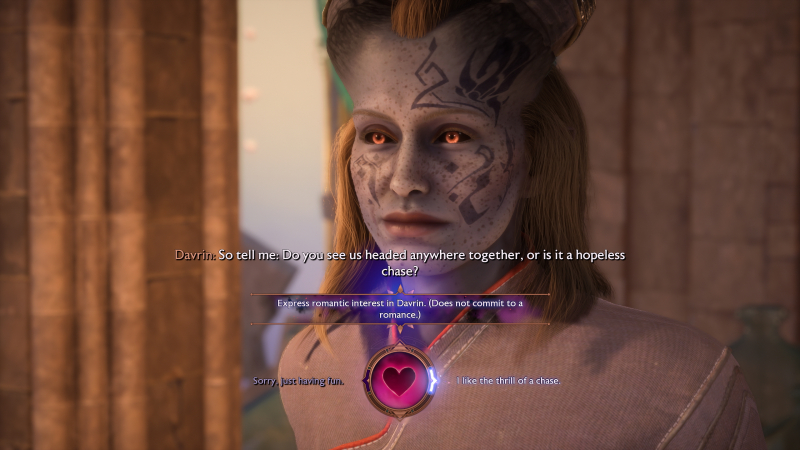
Of course, you can also start romantic relationships with companions. Or at a key moment make a choice that will close this opportunity forever
In addition to heart-wrenching personal quests, the game also offers a sea of side quests. They range from simple “run-win-bring” to full-fledged mini-plots, with intrigue, investigations and unexpected twists. In terms of effectiveness and soulfulness, these stories, of course, do not reach the main line or the plots of the companions, but as additional touches to the world they work well. In addition, each side quest is not only additional experience and rewards, but also a small step towards a brighter ending.
Each side quest brings one of the factions a certain amount of power, which will play a role in the final act of the game. And here, of course, the analogy with Mass Effect 2 arises again (what can we do – a cult example), where the degree of tragedy of the ending depended on our actions, completed tasks, leveling up the Normandy and relationships with companions. Likewise, in Dragon Age: The Veilguard, everything that happens in the final act feels like a derivative of our actions and actions, and the grand finale of the story feels truly its own. And it is precisely for this experience that players have always valued games from BioWare.
Advantages:
- An exciting fantasy adventure – staged on a grand scale and written with soul;
- An exciting main plot and equally addictive stories of companions;
- Deep and detailed role-playing system;
- The new combat system turned out to be dynamic, rich, moderately complex and, most importantly, truly fun.
Disadvantages:
- If tactical battles from previous games in the series were paramount for you, then the new system will most likely frustrate you;
- Minor technical problems such as slowdowns in certain locations or rare crashes;
- The decisions made in Inquisition don’t play a big role in The Veilguard.
Graphic arts
Bright stylized fantasy image, spectacular combat effects, detailed and atmospheric locations, meticulous character design – Dragon Age: The Veilguard looks great.
And the videos in the game are staged on a grand scale. The dramatic part is traditionally handled by dialogue segments, staged mostly in simple figure eights, but there are also episodes staged in a more intricate way – in such segments, camera movements create a separate visual drama and delight with interesting visual techniques. And, of course, we must pay tribute to the excellent facial animation – the characters “play” truly convincingly.
Sound
Dragon Age: The Veilguard sounds as great as it looks: where it needs to be deafeningly loud and impressive, where it needs to be restrained and atmospheric.
The soundtrack also turned out great, both deftly immersing you in the mood of certain locations and providing an emotional background during epic, mysterious, dramatic and other scenes.
And, of course, one cannot fail to note the voice acting – the actors fit exactly into the characters and are very convincing in their roles.
Single player game
An epic, spectacular, dynamic and incredibly exciting fantasy adventure.
Estimated time of completion
The story campaign will take about twenty hours if you rush to the final credits, bypassing most of the secondary activities. It will take about thirty to forty hours if you want to see all the companion stories and some of the side quests. And if you want to explore everything that The Veilguard offers, then prepare seventy to eighty hours of free time.
Collective game
Not foreseen.
General impression
The Veilguard changed the Dragon Age series in many aspects – visual, narrative, gameplay. But the essence remains the same – this is a fascinating, touching and large-scale fantasy adventure that will not leave the player indifferent.
Rating: 9.0 / 10
More about grading system
Video: